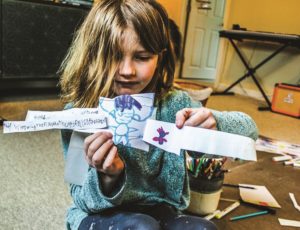WELLFLEET — Lisa Palladino is an artist and an expressive art therapist who lives in Wellfleet with her husband and two children. Ten-year-old Sterling is in fourth grade and Poppy, age seven, is in second grade. In response to the Independent’s call for creative projects, Palladino suggested the “Scribble Game,” an activity that invites adults and children to explore and discuss their feelings.
“This is actually an art therapy exercise I use a lot with kids,” Palladino says. “But adults can play it as well. The results are often surprising. I believe that people have a natural understanding of what heals them, which can be very unconscious. We are really our own best experts.”

What this activity facilitates, Palladino says, is listening. You don’t have to be a professional, she adds, to allow other people to use their imaginations to reveal what it is they need.
Home schooling comes with a lot of work from school, Palladino observes. The Scribble Game provides a break from all that structure. After playing it this past week, her children asked, “Is it OK if I do this? Is it OK if I do that?” Her answer was, “Yes — this is your chance to explore.”
“We are facing a lot of constraints at the moment,” Palladino says. “We can’t go to the store; we can’t go to the movies. This is an activity where they can just let go. And that was really interesting to witness.”
All that is needed for this playful project is a piece of white paper and a box of crayons, markers, or pastels, as well as scissors and tape or glue.

Step 1: One person folds the paper in half three times to form eight equal rectangles. Players are invited to use different colors to quickly and freely make a squiggle in each rectangular frame. There is no wrong way to do this. Each person can make her own set of scribbles, or if younger children are playing, the adult and child may take turns.
Step 2: Next, study your scribbles for potential images. You might find, for example, an everyday object like a chair, person, or animal. Players talk about whatever they see in their own scribbles.
Step 3: Next, complete each scribble by adding to what is already there. For example, one scribble may become a flower, another a face wearing a mask, and so forth.
Step 4: Write a title for each image, in pencil, inside each rectangle. Titles may be short and concrete, such as “boat” or “tall tree,” or expressive, such as “confusion” or “a sad face” or “a monster called Meanie.”
Step 5: Cut the boxes out. Now players can move their scribble images around. At this point, there are several options. Players could ask each other which scribbles they like best. Or they might tell a spontaneous story using the titles. Some children might love to rank the pictures in order of preference. Others might develop their own creative activity with additional paper and glue or tape.
Palladino’s two children took the game in different directions. “Sterling is someone who loves science and math,” she says. “He turned it into a science project, writing down facts and species types for his drawings.” Poppy had another process altogether. She wrote a story and then cut all the pictures out and added other elements, then rearranged, stapled, and taped things together.
The game makes space for challenging topics to arise. Palladino advises parents not to emphasize the scary parts, but not to sweep them under the rug either. Try to reframe worries, she says.
“For example, ‘I know we don’t get to see our friends, but we do get to cook a lot together at home, and I do get to give you more hugs during the day,’ ” Palladino says. “Little things like that, geared toward your particular child, go a long way.”



